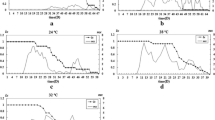Abstract
Oviposition and fecundity in the grain miteAcarus siro were studied at 5–30°C and 62.5–90% RH. At and above 20°C, 80% RH, mating and oviposition occurred soon after emergence, but at lower temperatures and humidities egg laying was progressively delayed from one to several days. Females needed to mate repeatedly in order to achieve maximum egg production, optimum conditions for which were 15°C, 90% RH, where total output per female averaged 435 with a maximum of 858. Oviposition rates were highest at higher temperatures, the mean daily rate at 20 and 25°C, 90% RH, rising to maximum levels of 28/29 eggs per female per day on day six.
Oviposition followed clearly defined patterns, favourable conditions producing rapid increases in the mean daily oviposition rate to high peak levels reached at an early stage in the oviposition period. Less favourable conditions resulted in reduced outputs and lower, more uniform rates of egg laying. The mean oviposition period, varying with humidity, fell from 72–122 days at 5°C to 9–13 days at 30°C and the mean incubation period from 42–70 days at 5°C to 3–4 days at 30°C. Egg viability increased with increasing humidity but was little affected by temperature and unaffected by age of the female at time of oviposition.
Males tended to live longer than females at most conditions; longevity—depending on humidity—averaging 13–15 days at 30°C and 129–175 days at 5°C. Adult life for females averaged 12–19 days at 30°C and 88–169 days at 5°C. An ‘index of suitability’, calculated from egg number, viability and duration of the egg stage and oviposition period, indicated that the most favourable conditions for oviposition and hatching were 20–25°C and 80–90% RH.
Similar content being viewed by others
References
Boczek, J., 1957. The grain mite (Tyroglyphus farnae); morphology, biology and ecology, its depredations and tests of control measures. Rocz. Nauk Roln., 75-A-4: 559–655 (in Polish, with English summary).
Boczek, J. and Czajkowska, B., 1976. Studies on the fecundity of Acarid mites. E.P.P.O. Bull., 6: 323–330.
Cunnington, A.M., 1965. Physical limits for complete development of the grain miteAcarus siro L. (Acarina, Acaridae) in relation to its world distribution. J. Appl. Ecol., 2: 295–306.
Fisher, R.C., 1938. Studies of the biology by the Death Watch beetleXestobium rufovillosum De Geer. II. The habits of the adult with special reference to the factors affecting oviposition. Ann. Appl. Biol., 25: 155–180.
Griffiths, D.A. and Boczek, J., 1977. Spermatophores of some Acaroid mites (Astigmata: Acarina). Int. J. Insect Morphol. Embryol., 6: 231–238.
Howe, R.W., 1971. A parameter for expressing the suitability of an environment for insect development. J. Stored Prod. Res., 7: 63–65.
Idhe, K.D., 1953. The biology and control of cheese mites. Ph.D. thesis (Entomology), Univ. Wisconsin, Madison, WI,
Newstead, R. and Duvall, H.K., 1918. bionomic, morphological and economic report on the acarids of stored grain and flour. R. Soc. Rep. No. 2. Grain Pests (War) Committee, London.
Peace, D.M., 1983. Reproductive success of the miteAcarus siro L. on stored cheddar cheese of different ages. J. Stored Prod. Res., 19: 97–104.
Solomon, M.E., 1946. Tyroglyphid mites in stored products. Ecological studies. Ann. Appl. Biol., 33: 82–97.
Solomon, M.E., 1951. Control of humidity with potassium hydroxide sulphuric acid, or other solutions. Bull. Entomol. Res., 42: 543–554.
Solomon, M.E., 1962. Ecology of the flour miteAcarus siro (=Tyroglyphus farinae De G.). Ann. Appl. Biol., 50: 178–184.
Solomon, M.E. and Cunnington, A.M., 1964. Rearing Acaroid mites. In: Proc. 1st int. Congr. Acarology, Fort Collins, CO, Acarologia, 6: 399–403.
Stanley, J., 1946. The environmental index, a new parameter as applied toTribolium. Ecology, 27: 303–314.
Author information
Authors and Affiliations
Rights and permissions
About this article
Cite this article
Cunnington, A.M. Factors affecting oviposition and fecundity in the grain miteAcarus siro L. (Acarina:Acaridae), especially temperature and relative humidity. Exp Appl Acarol 1, 327–344 (1985). https://doi.org/10.1007/BF01201572
Received:
Issue Date:
DOI: https://doi.org/10.1007/BF01201572




